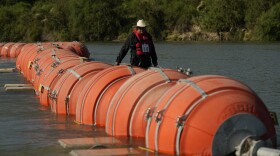This story is part of #CoveringClimateNow, an effort by more than 220 news organizations worldwide to bring about a greater understanding of the real-time impacts of climate change.
When many of us think of climate change, we still too often think of polar bears and the year 2100 — things far away and long into the future. But climate change is impacting us here and now.
This week, KPBS is joining 250 news organizations from across the globe, with a combined audience of over 1 billion, to bring home the urgent need to confront the realities of a warming planet.
We’ll visit a Ramona couple whose home was among the more than 1,000 lost in 2007’s Witch Creek Fire, which scorched nearly 200,000 acres in San Diego County and forced the evacuation of a half-million county residents.
RELATED: San Diego’s Climate Crisis: The Risks And Costs Of Living In The Backcountry
However, rather than flee the backcountry, Pete Beauregard and Amy Quinlan stayed and rebuilt in the place they love. But that choice carried with it a considerable cost. Over the decades, their annual homeowners' insurance bill has gone from $1,500 to $55,000.
Such eye-popping costs are part of the new normal on a warming planet, said David Victor, a professor at the UC San Diego School for Global Policy and Strategy and expert on the policy implications of climate change.
“I think some people who live in that environment are willing to spend huge resources to protect themselves with bigger fire breaks,” Victor said. “The next thing you know, you're in effect managing the entire wood ecosystem because of your concerns about fire."
The ever-increasing wildfire threat has even changed how California’s Army National Guard operates. We travel to Fresno, where the Maj. Robert Langston, commander of a local Cal Guard unit who lives in Pine Valley, leads a new statewide task force focused on clearing brush and creating fire breaks.
When Langston signed up, he knew his duties would include dealing with the impacts of fire. He didn’t know firefighting would be almost his entire job.
“Our level of support has been increasing,” Langston said. “We’ve been providing more and more support, especially to wildland fires. From a firefighting standpoint fires are getting more and more intense.”
San Diego County’s climate change impacts don’t end at the forest’s edge. They are also felt up and down the coast.
We visit Carlsbad Aquafarm, a small hatchery that’s been selling oysters and mussels to restaurants for 50 years. The industry was devastated a decade ago by ocean acidification caused by the warming ocean, said Matt Steinke, Aquafarm’s production manager.
“When ocean acidification hit the Pacific Northwest, they were reporting a 90 - to - 95 percent failure in their normal production and you ended up with a lot of farmers who had open space to grow things and they are unable to buy seed,” Steinke said. “And that problem persisted for a few years.”
The industry survived by moving operations south where the acidification is not as acute. But the threat is not going away, said Dan Cayan, an SIO climate change researcher.
“The warmer the oceans get, the less oxygen it can accommodate,” Cayan said. “And low oxygen is not good in general for ecosystems.”
At the southern edge of the county in Imperial Beach, the urgency is sea-level rise. While coastal flooding is something California’s lowest-lying beach community has always dealt with, sea-level rise caused by climate change is making it worse, said Robert Guza, a professor emeritus at SIO.
“Imperial Beach is a great example of a city between a rock, a hard place and a vice,” Guza said. “On one side you have the ocean. On the other side is the Tijuana Estuary...it can and does get flooded from both sides.”
Guza is especially worried for Imperial Beach because the sea level rise is happening while the region suffers from a perpetual shortage of beach sand.
“Rising sea level will take a chronic problem — shortage of sand. And see how bad it can get, just flooding the beaches on top of it that are already sand-starved,” he said.
Robert Stabenow spent his childhood surfing the waves of Imperial Beach. Now, as the city’s lifeguard captain, part of his job is to protect residents and property when waves wash into city streets.
“We’re hearing more and more about possible climate change and sea-level rise,” Stabenow said. “And now we’re actually seeing the impacts. It’s real, you know.”
As these stories unfold it will become even more apparent that San Diego is in the grip of a climate crisis.







